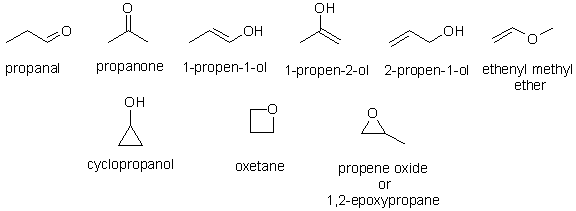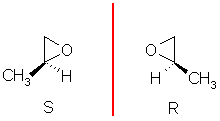
EA:
The data adds up to 100% so we know the elements involved : C, H and O.
%C = 62.04 divide by atomic weight
62.04 / 12.011 = 5.165
%H = 10.41 divide by atomic weight 10.41 / 1.008 = 10.327
%O = 27.55 divide by atomic weight 27.55 / 15.999 = 1.722
Now divide by the smallest to get the
simplest ratio : C = 5.165/1.722 = 2.999, H = 10.327/1.722 =
5.997, O = 1.722/1.722 = 1.000
Remember to be very careful when
rounding during during EA
calculations (it will
invariably mean you get the wrong answer if you round too far) AND if
you add up the MW
using accurate atomic weights it should match exactly.
So we have the empirical (molecular)
formula = C3H6O.
Index
of hydrogen deficiency ? Either draw out an example and count the
pi
bonds and rings, or use the
formula....
IHD = 1
So what functional groups could we have
? The formula is
unsaturated (IHD > 0) so we can have double bonds or rings too in
the structures.....
We could have the following functional groups :
Many students failed to
remember the basic rules of
valence a drew O and C atoms that violated the octet rule by having too
many bonds.
Constitutional isomers have different
connectivities due to
different functional groups or branching. The biggest errors were
students
not checking the molecular formula, and not even drawing a pair of
isomers or poor nomenclature !

Enantiomers are non-superimposable
mirror images, for that they need
a chirality center, which is this case needs to be an sp3 C
with 4 different substituents attached. There is only one
possibilities for C3H6O. The biggest error was
drawing a molecule that lacked a chirality center or didn't show it in
3D (they are stereoisomers after all). Final task was to assign
as R
or S. Here the groups are in priority order O > CH2O >
CH3 > H.

Note that
cyclopropanol is not chiral as it has a mirror plane or where is the C
with 4 different groups attached ?